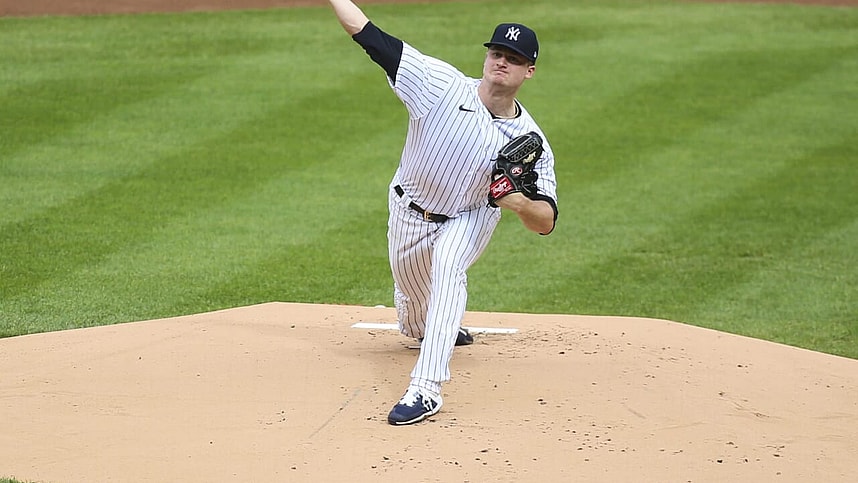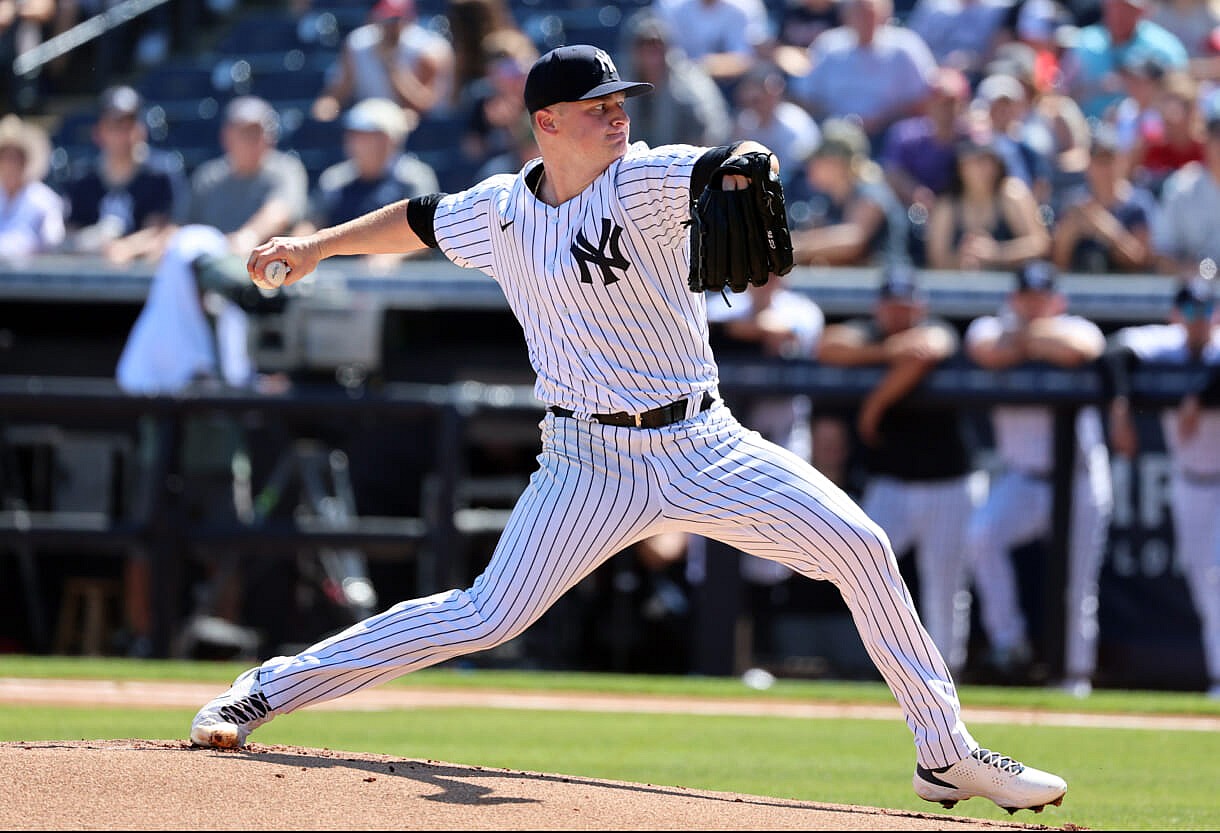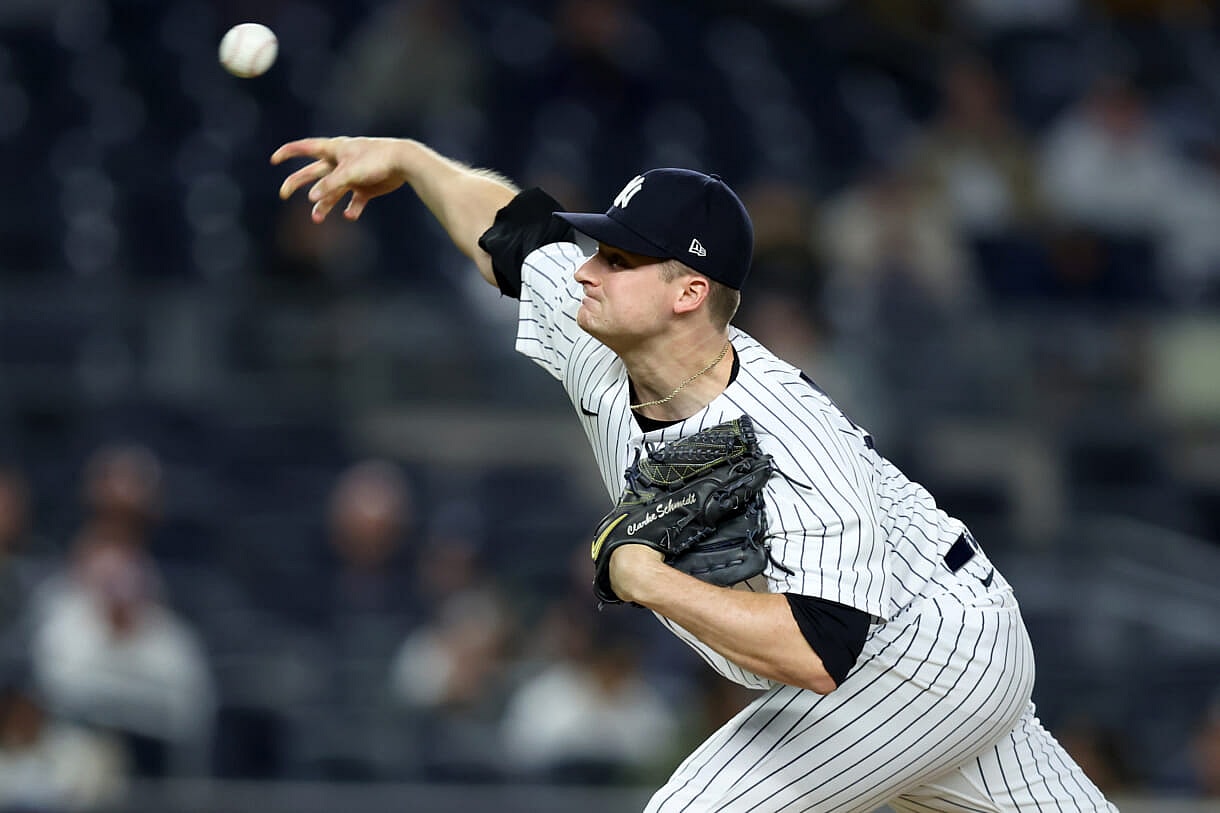
During an untelevised game last week, Clarke Schmidt put on a show for those in attendance at George M. Steinbrenner Field. Schmidt wasn’t just good, he was perfect, not allowing a single baserunner and striking out seven batters across five innings, doing so in just 50 pitches. While it’s just Spring Training, the impressive ability to generate swings and misses while attacking the strike zone is highly encouraging. The new cutter he’s throwing is working wonders for the former University of South Carolina ace, and the Yankees might have their hands on a breakout candidate.
- Updating the Yankees’ top 5 starting pitching targets for 2026
- Major Mistake: Yankees’ Brian Cashman opens up about a Jazz Chisholm Jr. trade
- Yankees might need to offer 4 year contract to reunite with Michael King
Clarke Schmidt is Making All of the Right Improvements
In an article discussing why Clarke Schmidt should be in the rotation over Domingo German, I cited the importance of Called Strike + Whiff%. This metric has a strong correlation with strikeout rate, and the majority of elite pitchers in today’s game boast an above-average strikeout rate. Clarke Schmidt underperformed his strikeout rate relative to his CSW% in 2022, as he had a 30.2% CSW% with a mere 23.7% K%. This was an area for potential improvement that the former first-round pick could hone in on, but the biggest question mark I had about Schmidt at the time was how he’d deal with left-handed batters.
I believed the changeup or four-seam fastball shapes would need to improve, but instead, Schmidt added a cutter to his arsenal. This came as huge news for those paying close attention since cutters are a great contact pitch that also generates plenty of swings. This meant Schmidt would have a primary fastball for lefties that he could throw over the heart of the plate and attack batters with since it could “miss” in the zone and still generate a called strike, whiff, or weak contact. So far, Schmidt has a 35.2% CSW% in Spring Training, an incredible improvement on last year’s total.
This has resulted in a ridiculous strikeout-to-walk ratio of 17:1 so far, and while his 4.63 ERA isn’t pretty, the ability to generate ideal outcomes in the form of strikeouts while avoiding walks is far more indicative of success come the regular season. He’s also generating groundballs at a 65.3% clip, and we see that pitchers with high groundball totals and strong K-BB% numbers tend to prevent runs at an elite level. Last season, the league average K-BB% was 14.3%, and the league average GB% was 42.9%.
35 starters finished with over 100 IP and a better-than-league-average K-BB% and GB%, and 31 of them finished with an ERA below the 2022 average of 3.97, with 24 of them posting an ERA below 3.50. Groundballs and strikeouts prevent runs, even in a world with limited shifts. It’s hard to deny that the cutter has played a massive role in Schmidt’s early success, as it’s proven to be an incredible fastball for him at 92.6 MPH and glove-side movement that profiles really well with his larger breaking balls like his slider or curveball.
We’ve emphasized the importance of strikeouts, groundballs, and limiting walks, but what about a pitcher’s approach? Just like a hitter, every pitcher is wired differently, having dramatically different approaches based on their pitch mix or pitching philosophy. For Clarke Schmidt, we’re seeing renewed confidence that we haven’t seen in his tenure as an MLB regular.

27% of pitches thrown by Clarke Schmidt were thrown over the “heart” of the plate per Statcast in 2022, in Spring Training he’s up to 35.8%. In terms of just in-zone pitches, 54.5% of pitches thrown by Schmidt in Spring have been in-zone, while in 2022 it was 50.4%. There’s an added aggression to Schmidt’s approach on the mound, and the cutter plays a huge role in that. You should credit Matt Blake and the Yankees’ pitching development for helping Schmidt with the shape of this cutter, but you should also credit Schmidt with making the adjustment on the mound to go out and pound the strike zone with his pitches.
This does one of two things; first, it helps a pitcher avoid walks, which, as mentioned earlier, affects your ability to prevent runs. K-BB% is a great indicator of run prevention, and Schmidt was below the league-average mark last year because of his high walk rate. Issuing fewer free passes also means shorter innings, which reduce in-game fatigue and can get a pitcher through the order more often and allowing them to eat up more innings. Secondly, this helps a pitcher generate more out-of-zone swings, and that’s something he struggled with in 2022.
Finding his confidence in the zone has led to a sub-3% BB% in the small sample we have so far in Spring Training, but it’s a sign that he could finally maintain a better-than-league average walk rate this season. Strikeouts, walks, and groundballs are metrics I’ll always value for pitchers because of their correlation with run prevention, and Clarke Schmidt isn’t any different.
Do the Yankees Have a Longterm Starter in Schmidt?
The only way for us to truly know is based on his 2023 season. I imagine the Yankees will have him limit his times through the order early on, and they certainly have the bullpen to do so. This seems like I’m complaining about Rodon’s injury being seemingly minor, but trust me, I’m taking Rodon over anyone in the sport when healthy outside of five or six other starters. That being said, it does create a weird situation when he returns where the Yankees are going to have to make a judgment call on Schmidt or German with just two or three starts under their belt in the 2023 season.
As big of a fan as I am of Schmidt, German’s a notoriously slow starter. He had an ERA of 9 and FIP of 9.46 through his first two starts in 2021 and an ERA of 6.39 through his first three starts of 2022. Schmidt on the other hand, could struggle early on in the ERA department but boast a strong K-BB%, but get ousted from the rotation even if he’s due for positive regression. It’s a weird situation where I don’t know if Schmidt is going to make enough starts this season for us to have a meaningful sample size to answer this question.

I certainly believe Clarke Schmidt has shown us incredible potential this Spring Training, but now he has to put everything together and take advantage of limited opportunities to stick in the rotation. At the very least, I think Schmidt is going to be a really good reliever. The Yankees have an arm that, in one way or another, will help this team immensely, and as the old adage goes, you can never have too much pitching. It’ll be interesting to see how the Yankees manage his innings and his workload, but what I do know is that Schmidt is pushing all the right buttons so far this Spring.
More about: New York Yankees